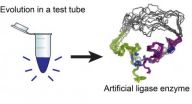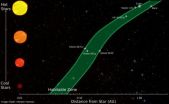(Press-News.org) PROVIDENCE, R.I. [Brown University] — Even in our DNA there is no refuge from rogues that prey on the elderly. Parasitic strands of genetic material called transposable elements — transposons — lurk in our chromosomes, poised to wreak genomic havoc. Cells have evolved ways to defend themselves, but in a new study, Brown University researchers describe how cells lose this ability as they age, possibly resulting in a decline in their function and health.
Barbara McClintock, awarded the Nobel Prize in 1983, made the original discovery of transposons in maize. Since then scientists have found cases in which the chaos they bring can have long-term benefits by increasing genetic diversity in organisms, but in most cases the chaos degrades cell function, such as by disrupting useful genes.
"The cell really is trying to keep these things quiet and keep these things repressed in its genome," said John Sedivy, professor of medical science in the Department of Molecular Biology, Cell Biology, and Biochemistry and senior author of the new study published online in the journal Aging Cell. "We seem to be barely winning this high-stakes warfare, given that these molecular parasites make up over 40 percent of our genomes."
Cells try to clamp down on transposons by winding and packing transposon-rich regions of the genome around little balls of protein called nucleosomes. This confining arrangement is called heterochromatin, and the DNA that is trapped in such a tight heterochromatin prison cannot be transcribed and expressed.
What the research revealed, however, is that carefully maintaining a heterochromatin prison system is a younger cell's game.
"It's very clear that chromatin changes profoundly with aging," Sedivy said.
What Sedivy, lead author Marco De Cecco, and their co-authors measured in several experiments was that young and spry cells distinctly maintain open "euchromatin" formations in regions where essential genes are located and closed "heterochromatin" formations around areas with active transposable elements and few desirable genes.
The distinction appeared to become worn in aging, or senescent, cells. In the observations, the chromatin that once was open tended to become more closed and the chromatin that was once closed, tended to become more open.
Working with computational biologist and Nicola Neretti, assistant professor of biology, Sedivy and De Cecco conducted a genome-wide analysis of these differences. The team extracted and then sequenced DNA from young and senescent human fibroblast cells using a technique called FAIRE. Essentially FAIRE uses chemicals such as formaldehyde to separate out DNA that is loosely packed in euchromatin from DNA that is more tightly wound up in heterochromatin.
Then the scientists compared the DNA that was coming from open or closed chromatin formations in the young and senescent cells.
"Given that our genomes contain well over a million copies of transposable elements and that they are very similar to one another, tracking all this mayhem is no easy matter," Neretti said. "Computationally speaking, it's a nightmare."
But Sedivy said results were well worth the effort. In their study not only did they find that the chromatin lockdown was breaking down, but also that the newly freed transposons were taking full advantage.
"I was really surprised to see that first of all these transposable elements start to get expressed and that they actually start moving around [to other regions in the genome]," Sedivy said. "That's really an amazing thing."
How bad and how to stop it?
What's not clear from the study is the relevance of the damage that the cells suffer from the transposable element jailbreak and resulting genetic crime spree. That depends on the timing, which Sedivy's team measured only in approximate terms.
"Is the transposition really bad for the organism or is it something that happens so late that by that point the organism has already accumulated so much age-associated damage?" he asked. "Then maybe this extra insult of transposition is not going to make a lot of difference."
The question matters, Sedivy says, because drugs might be able to suppress transposons in aging cells. Virtually all of the transposons of concern in mammals are so-called "retrotransposons" because they use RNA and an enzyme to copy themselves. Certain HIV drugs work by these enzymes called "reverse transcriptases." Remarkably, Sedivy said, the reverse transcriptase of the major human retrotransposons called "L1" has been shown by researchers to be inhibited by some HIV drugs widely used in the clinic.
"The prospects of coming up with an existing drug therapy is something we really need to think about seriously," he said. "We're definitely going to test that and in the future, if needed, we also should be able to design new drugs that are highly specific for L1."
Ultimate success would provide a way to restore order in the cells and forestall at least some of the molecular ravages of age.
INFORMATION:
In addition to Sedivy, De Cecco, and Neretti, other authors on the paper are Steven Criscione, Edward Peckham, Sara Hillenmeyer, Eliza Hamm, Jayameenakshi Manivannan, Abigail Peterson, and Jill Kreiling.
The National Institute on Aging (grants R37 AG016694, K25 AG028753, K01 AG039410) provided primary funding for the research. Sedivy was also supported by the Glenn Medical Foundation. The researchers performed their high-throughput sequencing in the Genomics Core Facility at Brown's Laboratories for Molecular Medicine.
Aging cells lose their grip on DNA rogues
2013-01-30
ELSE PRESS RELEASES FROM THIS DATE:
GEOLOGY starts 2013 with 25 new articles posted online ahead of print
2013-01-30
Boulder, Colo., USA - Geology content posted online 4 through 25 January 2013 cover topics from greenhouse gas emissions to video observations of erupting geysers in Russia and from the age of Earth to the age of Grand Canyon. Highlights and detailed information about each article are listed below.
1. Earth is mostly flat
2. Age maps of early Earth
3. Sagaing fault, Indo-Burmese wedge
4. Anthropogenic lead
5. The growth of a newly born submarine volcano
6. The Hemlo gold deposit, Ontario, Canada
7. Reptile and mammal fossils in the Karoo Basin, South Africa
8. ...
U. of Minn. researchers unveil first artificial enzyme created by evolution in a test tube
2013-01-30
There's a wobbly new biochemical structure in Burckhard Seelig's lab at the University of Minnesota that may resemble what enzymes looked like billions of years ago, when life on earth began to evolve – long before they became ingredients for new and improved products, from detergents to foods and fuels.
Seelig created the fledgling enzyme by using directed evolution in the laboratory. Working with colleague Gianluigi Veglia, graduate student Fa-An Chao, and other team members, he subsequently determined its structure, which made its debut December 9 as an advance online ...
Researchers develop model for identifying habitable zones around star
2013-01-30
UNIVERSITY PARK, Pa. -- Researchers searching the galaxy for planets that could pass the litmus test of sustaining water-based life must find whether those planets fall in a habitable zone, where they could be capable of having liquid water and sustaining life. New work, led by a team of Penn State researchers, will help scientists in that search.
Using the latest data, the Penn State Department of Geosciences team has developed an updated model for determining whether discovered planets fall within a habitable zone. The work builds on a prior model by James Kasting, ...
Reconcilable differences: Study uncovers the common ground of scientific opposites
2013-01-30
Searching for common elements in seemingly incompatible scientific theories may lead to the discovery of new ones that revolutionize our understanding of the world.
Such is the idea behind a mathematical framework Princeton University researchers developed that strips away the differences between scientific laws and theories to reveal how the ideas are compatible. In a recent report in the journal Physical Review Letters, the authors explain how the mathematical model finds common ground between the famously at-odds physics equations that govern classical and quantum ...
Mindfulness meditation heightens a listener's musical engagement
2013-01-30
EUGENE, Ore. -- (Jan. 30, 2013) -- When De'Anthony Thomas returned the opening kickoff for a touchdown in the 2013 Fiesta Bowl, says University of Oregon researcher Frank Diaz, Thomas put Ducks fans into a heightened zone of engagement for watching the game, not unlike what was experienced by music students who were first exposed to a brief session of mindfulness meditation before hearing an opera passage.
As a high school orchestra and band educator in Florida, Diaz had flirted with yoga and light meditation in a quest to heighten music engagement. He noticed, anecdotally, ...
Chronic kidney disease increases risk of death for both women and men
2013-01-30
A new study from the Johns Hopkins Bloomberg School of Public Health and the Chronic Kidney Disease Prognosis Consortium (CKD-PC) found that in general chronic kidney disease is similarly associated with a higher risk of death and end stage renal disease for both women and men. The findings were released online in advance of publication in BMJ.
Chronic kidney disease affects 10 to 16 percent of adults worldwide. Current thresholds for chronic kidney disease are based on two kidney measures, estimated glomerular filtration rate (GFR) and albuminuria, a measure of protein ...
Researchers help confirm value of flow-diverting device for most challenging aneurysms
2013-01-30
CINCINNATI—A multi-center study supports the effectiveness of the newest technology available for the treatment of difficult, life-threatening brain aneurysms. The technology, the Pipeline embolization device, is a flow diverter that redirects blood flow away from wide-necked or giant aneurysms that cannot be treated in more conventional ways.
Andrew Ringer, MD, director of the division of cerebrovascular surgery and professor of neurosurgery and radiology at the University of Cincinnati (UC) College of Medicine, led the Cincinnati portion of the study, which was published ...
Scientists uncover previously unknown mechanism of memory formation
2013-01-30
JUPITER, FL, January 30, 2013 – It takes a lot to make a memory. New proteins have to be synthesized, neuron structures altered. While some of these memory-building mechanisms are known, many are not. Some recent studies have indicated that a unique group of molecules called microRNAs, known to control production of proteins in cells, may play a far more important role in memory formation than previously thought.
Now, a new study by scientists on the Florida campus of The Scripps Research Institute has for the first time confirmed a critical role for microRNAs in the ...
Study: Alternate walking and running to save energy, maintain endurance
2013-01-30
COLUMBUS, Ohio—Forget "slow and steady wins the race." A new study shows that, at least sometimes, the best way to conserve energy and reach your destination on time is to alternate between walking and running—whether your goal is the bus stop or a marathon finish line.
In the January 30, 2013 issue of the Journal of the Royal Society Interface, researchers examined how people budget their time as they travel on foot to reach a destination at a particular appointed time. The study found that when people have neither too much time nor too little time to reach their destination, ...
In-brain monitoring shows memory network
2013-01-30
Working with patients with electrodes implanted in their brains, researchers at the University of California, Davis, and The University of Texas Health Science Center at Houston (UTHealth) have shown for the first time that areas of the brain work together at the same time to recall memories. The unique approach promises new insights into how we remember details of time and place.
"Previous work has focused on one region of the brain at a time," said Arne Ekstrom, assistant professor at the UC Davis Center for Neuroscience. "Our results show that memory recall involves ...






